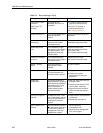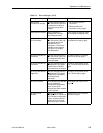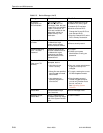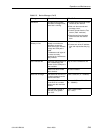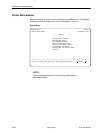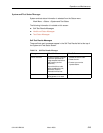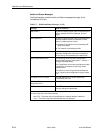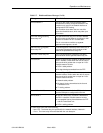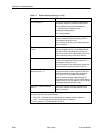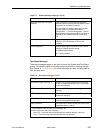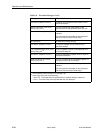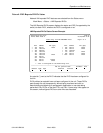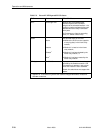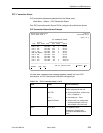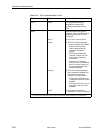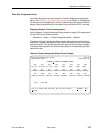
Operation and Maintenance
5-16
9124-A2-LB20-00
March 2000
Table 5-7. Health and Status Messages (3 of 4)
Message What It Indicates
OOF at Network 1 An Out of Frame (OOF) condition is detected on
the network interface. Possible reasons include:
H Incompatible framing format between the
network and the FrameSaver unit.
H Network cabling problem.
H T1 facility problem.
Primary Clock Failed A failure of the primary clock source configured for
the unit is detected and the secondary clock is
providing the timing for the unit.
This condition clears when the configured primary
clock is restored.
Primary & Secondary Clocks
Failed
A failure of the primary and secondary clock
sources configured for the unit are detected and
the internal clock is providing timing for the unit.
The clock source will not automatically switch from
internal until the primary clock source returns.
Secondary Clock Failed A failure of the secondary clock source configured
for the unit is detected and the internal clock is
providing the timing for the unit.
The clock source will not automatically switch from
internal until the primary clock source returns.
SLV Timeout, DLCI nnnn,
frame relay link
1,
2,
3
An excessive number of SLV communication
responses from the remote FrameSaver SLV unit
have been missed on the specified multiplexed
DLCI; the DLCI is not suitable for user data.
When a hardware bypass capable device has
been detected at the other end of the PVC and this
condition occurs, only user data for EDLCI 0 will be
transmitted while this condition exists.
Two Level-1 Users Accessing
Device
Two Level 1 users are already using the menu-
driven user interface; only two sessions can be
active at one time.
1
nnnn indicates a DLCI number of 16 through 1007.
2
frame relay link is one of the following:
– Net1-FR1. The frame relay link specified for the network interface, Network 1.
– Port-1. The frame relay link associated with the user data port.
3
Does not apply to a TS Management Link DLCI.



